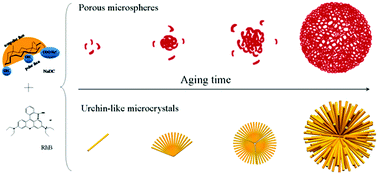Reversible controlled morphologies switching between porous microspheres and urchin-like microcrystals for NaDC/RhB self-assembly and their multifunctional applications†
Abstract
The hierarchical self-assembly of a biological surfactant, sodium deoxycholate (NaDC), and a cationic dye (RhB) through ionic self-assembly (ISA) opens up potentially useful routes to construct soft materials. Our results have shown that different morphologies with high hierarchies can be reversibly controlled by varying the ratio of the two components (NaDC and RhB) and that the morphologies can switch between porous microspheres and urchin-like structures. It can be concluded that the interaction between NaDC and RhB was strongly influenced by direct electrostatic forces between the –COO− groups in NaDC and –N+ in RhB, respectively. Moreover, because of the novel nanostructures, they have functional applications for photoluminescence enhancement and hydrophobicity. Thus, it can be expected that this ISA strategy can be used towards the development of new protocols for the fabrication of novel materials, which are potentially biocompatible and biodegradable and gives new insight into the main (soft-interactions) self-assembly processes.


 Please wait while we load your content...
Please wait while we load your content...